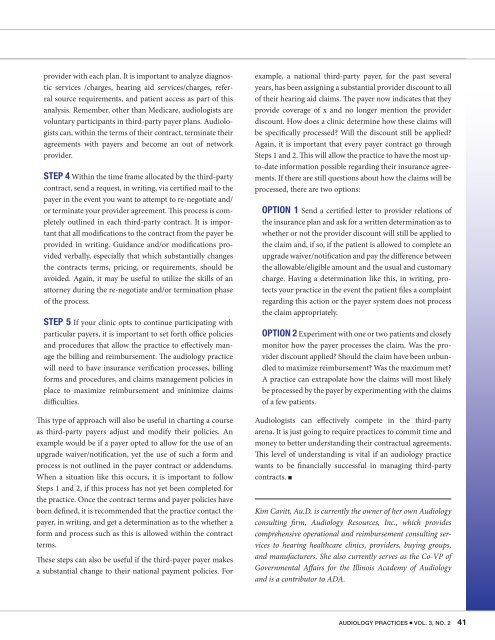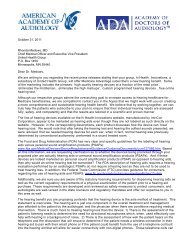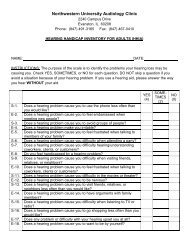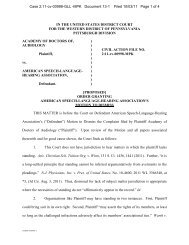IN THIS ISSUE - Academy of Dispensing Audiologists
IN THIS ISSUE - Academy of Dispensing Audiologists
IN THIS ISSUE - Academy of Dispensing Audiologists
Create successful ePaper yourself
Turn your PDF publications into a flip-book with our unique Google optimized e-Paper software.
provider with each plan. It is important to analyze diagnostic<br />
services /charges, hearing aid services/charges, referral<br />
source requirements, and patient access as part <strong>of</strong> this<br />
analysis. Remember, other than Medicare, audiologists are<br />
voluntary participants in third-party payer plans. <strong>Audiologists</strong><br />
can, within the terms <strong>of</strong> their contract, terminate their<br />
agreements with payers and become an out <strong>of</strong> network<br />
provider.<br />
STEP 4 Within the time frame allocated by the third-party<br />
contract, send a request, in writing, via certified mail to the<br />
payer in the event you want to attempt to re-negotiate and/<br />
or terminate your provider agreement. This process is completely<br />
outlined in each third-party contract. It is important<br />
that all modifications to the contract from the payer be<br />
provided in writing. Guidance and/or modifications provided<br />
verbally, especially that which substantially changes<br />
the contracts terms, pricing, or requirements, should be<br />
avoided. Again, it may be useful to utilize the skills <strong>of</strong> an<br />
attorney during the re-negotiate and/or termination phase<br />
<strong>of</strong> the process.<br />
STEP 5 If your clinic opts to continue participating with<br />
particular payers, it is important to set forth <strong>of</strong>fice policies<br />
and procedures that allow the practice to effectively manage<br />
the billing and reimbursement. The audiology practice<br />
will need to have insurance verification processes, billing<br />
forms and procedures, and claims management policies in<br />
place to maximize reimbursement and minimize claims<br />
difficulties.<br />
This type <strong>of</strong> approach will also be useful in charting a course<br />
as third-party payers adjust and modify their policies. An<br />
example would be if a payer opted to allow for the use <strong>of</strong> an<br />
upgrade waiver/notification, yet the use <strong>of</strong> such a form and<br />
process is not outlined in the payer contract or addendums.<br />
When a situation like this occurs, it is important to follow<br />
Steps 1 and 2, if this process has not yet been completed for<br />
the practice. Once the contract terms and payer policies have<br />
been defined, it is recommended that the practice contact the<br />
payer, in writing, and get a determination as to the whether a<br />
form and process such as this is allowed within the contract<br />
terms.<br />
These steps can also be useful if the third-payer payer makes<br />
a substantial change to their national payment policies. For<br />
example, a national third-party payer, for the past several<br />
years, has been assigning a substantial provider discount to all<br />
<strong>of</strong> their hearing aid claims. The payer now indicates that they<br />
provide coverage <strong>of</strong> x and no longer mention the provider<br />
discount. How does a clinic determine how these claims will<br />
be specifically processed? Will the discount still be applied?<br />
Again, it is important that every payer contract go through<br />
Steps 1 and 2. This will allow the practice to have the most upto-date<br />
information possible regarding their insurance agreements.<br />
If there are still questions about how the claims will be<br />
processed, there are two options:<br />
OPTION 1 Send a certified letter to provider relations <strong>of</strong><br />
the insurance plan and ask for a written determination as to<br />
whether or not the provider discount will still be applied to<br />
the claim and, if so, if the patient is allowed to complete an<br />
upgrade waiver/notification and pay the difference between<br />
the allowable/eligible amount and the usual and customary<br />
charge. Having a determination like this, in writing, protects<br />
your practice in the event the patient files a complaint<br />
regarding this action or the payer system does not process<br />
the claim appropriately.<br />
OPTION 2 Experiment with one or two patients and closely<br />
monitor how the payer processes the claim. Was the provider<br />
discount applied? Should the claim have been unbundled<br />
to maximize reimbursement? Was the maximum met?<br />
A practice can extrapolate how the claims will most likely<br />
be processed by the payer by experimenting with the claims<br />
<strong>of</strong> a few patients.<br />
<strong>Audiologists</strong> can effectively compete in the third-party<br />
arena. It is just going to require practices to commit time and<br />
money to better understanding their contractual agreements.<br />
This level <strong>of</strong> understanding is vital if an audiology practice<br />
wants to be financially successful in managing third-party<br />
contracts. n<br />
Kim Cavitt, Au.D. is currently the owner <strong>of</strong> her own Audiology<br />
consulting firm, Audiology Resources, Inc., which provides<br />
comprehensive operational and reimbursement consulting services<br />
to hearing healthcare clinics, providers, buying groups,<br />
and manufacturers. She also currently serves as the Co-VP <strong>of</strong><br />
Governmental Affairs for the Illinois <strong>Academy</strong> <strong>of</strong> Audiology<br />
and is a contributor to ADA.<br />
AUDIOLOGY PRACTICES n VOL. 3, NO. 2 41










